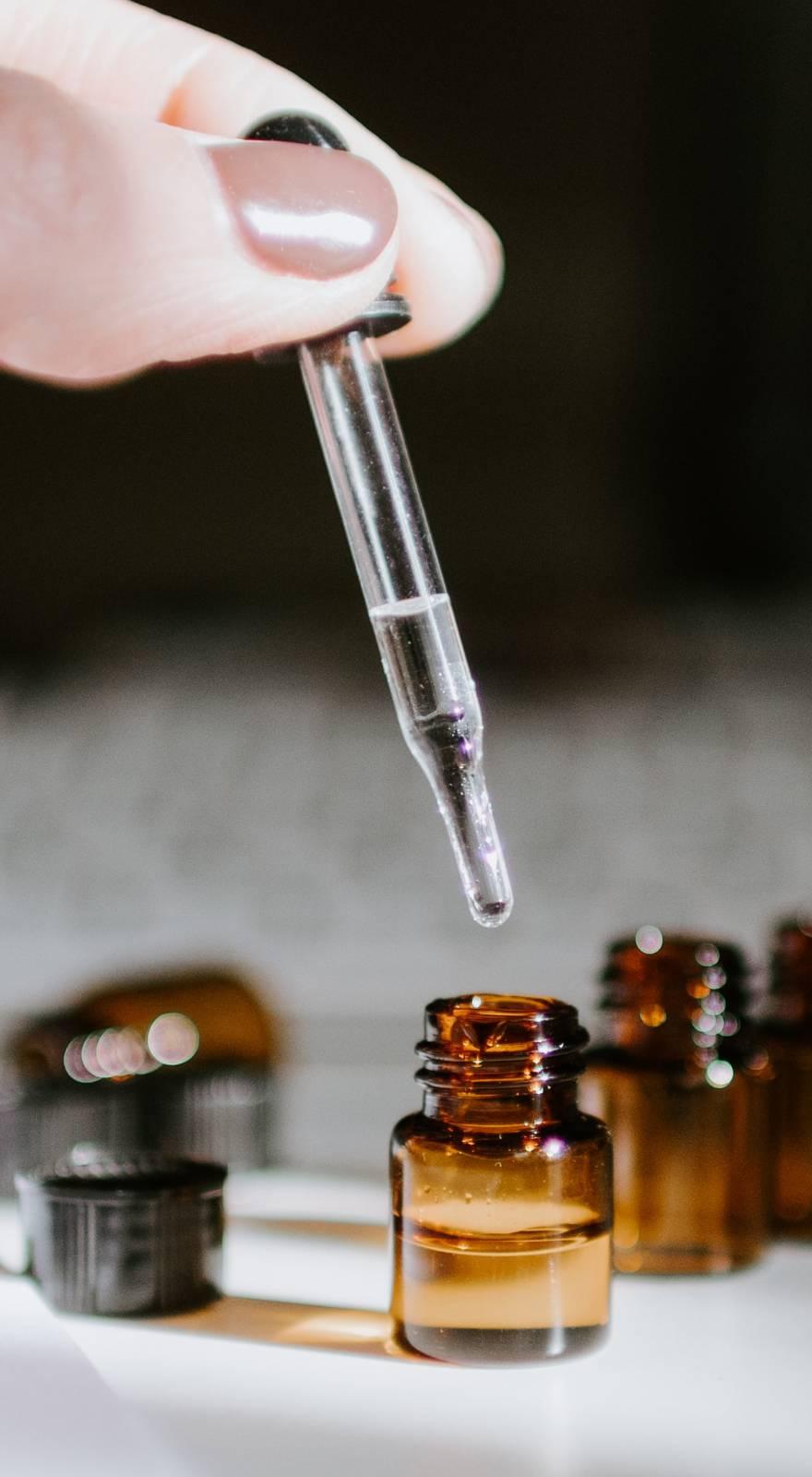Knowde Enhanced TDS
Identification & Functionality
- Carrier
- Cosmetic Ingredients Functions
- EINECS No.
- 231-791-2, 207-997-3, 247-668-1
- Technologies
- Product Families
- Origin
- Aqua - Mineral
- Propanediol - Vegetable
- Glyceryl Caprylate - Vegetable
- Lactococcus Ferment Extract - Bacterial
- Decyl Glucoside - Vegetable
Features & Benefits
- Labeling Claims
- Product Highlights
Our skin is an interface with the outside environment and, as such, is colonized by a diverse microbiota community. Certain bacterial species present in the axillary community have the capacity to transform non-odorous substances into volatile odorous substances by the action of enzymes. We can mention a very special involvement of Corynebacterium spp. and Staphylococcus spp.
The repeated use of deodorant to destroy the bacterial flora of the axillary microbiota does not appear to be the appropriate solution: bacterial abundance is decreased and led to the proliferation of inapropriate bacterial community when classical deodorant are stopped.
For this reason, GREENTECH designed a new active which limits proliferation of bad odors responsible bacteria without suppressing the other strains.- Action
- Reduces bacteria responsible for bad odors
- Maintains “good” bacteria
- Limits armpit bad odors
- Cosmetic Benefits
While preserving beneficial bacteria to respect microbiota balance, axillary bad odors disappear. LACTOPHYT® brings a sensation of comfort and freshness.
Applications & Uses
- Application Format
- Personal Hygiene Applications
- Cosmetic Use
- Deodorant
- Hygiene products
- Formulations
- Concentration for use: 2 %
- pH for use: 4.0 - 6.0
- Caution for use: Add to emulsions, at the end of the preparation process, either cold or at 35-40°C, during cooling.
Properties
- Physical Form
- Odor
- Characteristic
- Appearance
- Liquid
- Soluble in
- Water, Propanediol
- Partially Soluble in
- 10% in ethanol, 10% in water
- Quantifications
- Physico-Chemical Properties
- Microbiological Values
| Value | Units | Test Method / Conditions | |
| MIC against Brevibacterium epidermidis | max. 1 | % | GT121 |
| Value | Units | Test Method / Conditions | |
| Refraction Index | 1.370 - 1.410 | - | GT007 |
| Specific Gravity | 1.000 - 1.060 | - | GT008 |
| pH Value (Direct) | 4.5 - 5.5 | - | GT005 |
| Value | Units | Test Method / Conditions | |
| Detection of Enterobacteria | Absence | - | ISO 18415 |
| Enumeration of Mesophilic Aerobic Bacteria | max. 100 | ufc/mL - cfu/mL | ISO 21149 |
| Enumeration of Yeasts and Molds | max. 100 | ufc/mL - cfu/mL | ISO 16212 |
Regulatory & Compliance
- Certifications & Compliance
- REACH Status
INCI Concentration REACH Status Aqua 43 - 52.9 % Water exempted annex IV Propanediol 42 - 46 % Propanediol registered
n°01-2119489383-28Glyceryl Caprylate 3 - 8 % Glyceryl caprilate
registered n°01-2120119773-55Lactococcus Ferment Extract 2 - 4.5 % Exempt: < 1 ton/year (dry matter) Decyl Glucoside 0.1 - 1 % Decyl glucoside
registered n°01-2119488530-36
Technical Details & Test Data
- Scientific Mechanism
The objective is to limit the proliferation of species involved in the formation of malodour compounds.

Axillary microbiota Decrease of bacterial species responsible of bad odors
- Proven Efficacy
LACTOPHYT® limits growth of strains involved in the production of unpleasant odors, without disturbing “beneficial” bacteria competing with bacterial species generating bad odors.
Correlation between
bacteria and bad odorsLACTOPHYT® at 2% (v/v) No directly involved SPECIES 24h 48h 72h Positively correlated
with olfactory descriptor
(global, spivy or fresh onion)S. EPIDERMIDIS + + + S. HOMINIS - - + C. XEROSIS - - - C. TUBERCULOSTEARICUM - - - Initial bacterial concentration of 105 CFU/mL
Incubation at 37°C
The growth is considered as positive (+) when the OD600 is greater than 0.1 (compared to initial OD600 at 0h)
S. epidermidis: Staphylococcus epidermidis; S. hominis: Staphylococcus hominis; C. xerosis: Corynebacterium xerosis; C. tuberculostearicum: Corynebacterium tuberculostearicumStaphylococcus epidermidis
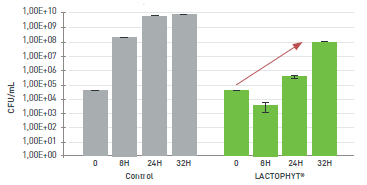
Staphylococcus hominis
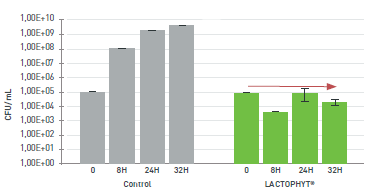
Corynebacterium xerosis
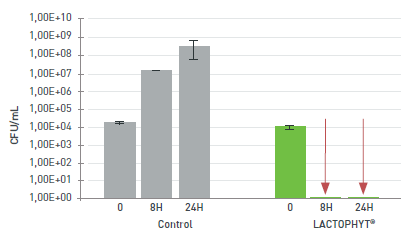
Initial bacterial concentration of 105 CFU/mL in presence of LACTOPHYT® (2%)
Results obtained after 8,24 and 32 hours of incubation at 37°CLACTOPHYT® selectively reduces the bacteria responsible for bad odors, preserving the axillary microbiota.
- Clinical Study
COMPARISON WITH PLACEBO
Double blind test with 18 volunteers. One daily application on armpit during 3 days with
LACTOPHYT® 2% versus an active formula containing talc and a perfume (here named
placebo). Auto-evaluated sniff-test on a 0 to 6-scale from no odor to very strong odor
(disturbing others).DAY 1
ODOR INTENSITY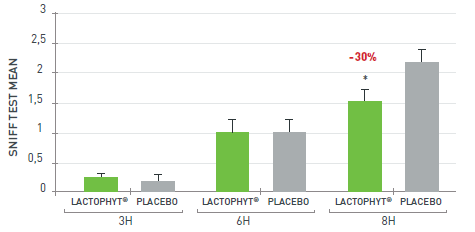
DAY 3
ODOR INTENSITY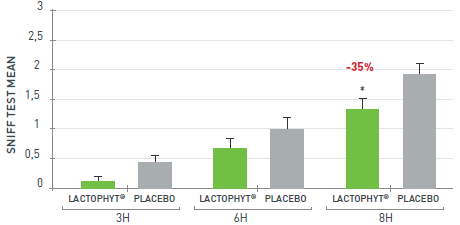
* p<0.05 / vs placebo
LACTOPHYT® has a higher deodorant power than placebo.
COMPARISON WITH TRIETHYLCITRATE
Double blind test with 20 volunteers. One daily application on armpit during 3 days with
LACTOPHYT® 2% versus TRIETHYLCITRATE 1% (percentage usually used). Auto-evaluated sniff test on a 0 to 6-scale from no odor to very strong odor (disturbing others).DAY 1
ODOR INTENSITY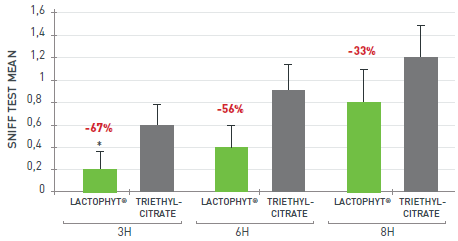
DAY 3
ODOR INTENSITY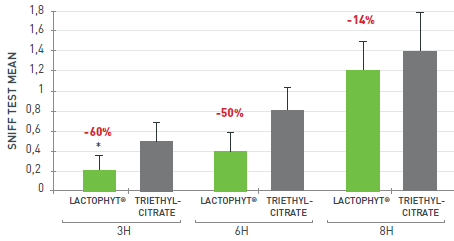
* p<0.05 / vs Triethylcitrate
LACTOPHYT® has the same deodorant power as Triethylcitrate currently use on the market.
Lactophyt® has a high deodorant power based on its capacity to inhibit growth of bacteria involved in the production of unpleasant odors.
Safety & Health
- Toxicological Tests
Tests Method Tested Concentration Results Eye Irritation Het cam 2 % Slightly irritant Sensitization HRIPT 2 % Very good skin compatibilit Skin Irritation Patch Test 2 % Very good skin compatibility
Storage & Handling
- Shelf Life
- 12 months
- Storage
15 / +25°C
Keep in the original packaging, without opening, in the recommended storage conditions.
Advice before use : Agitation
